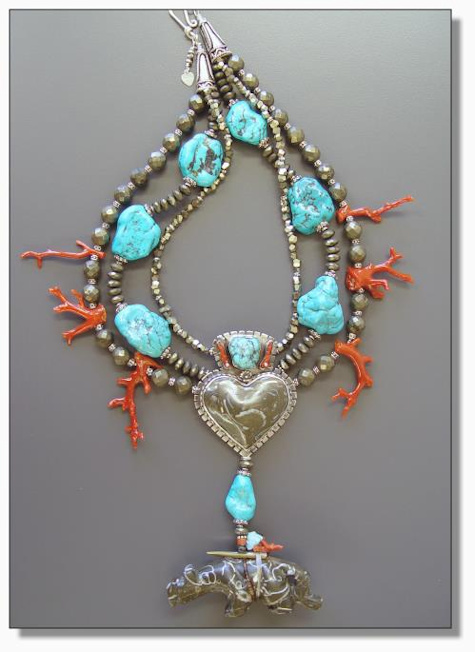Tsu: wah is a traditional Zuni name for a young man. It is the name the carver, Daryl Shack, Sr. gave to the lion. The lion, protective and hunting animal of the north, is the elder brother of all the protective and hunting animals. Lion has been called the Zuni St. Christopher because he protects travelers on their journeys. Bennett notes "Mountain Lion is chosen as the Guardian figure for very specific virtues, which include stealth, ferociousness, a highly developed territorial sense, and powerful instincts for detecting danger." The north is the place of wisdom on the medicine wheel.
Cushing recounts, "Then said Pó-shai-aŋ-k'ia to the Mountain Lion, 'Long Tail, thou art stout of heart and strong of will. Therefore give I unto thee and unto thy children forever the mastership of the gods of prey, and the guardianship of the great Northern World (for thy coat is of yellow), that thou guard from that quarter the coming of evil upon my children of men, that thou receive in that quarter their messages to me, that thou become the father in the North of the sacred medicine orders all, that thou become a Maker of the Paths (of men's lives).'" He also goes into detail about how mountain lion came to hunt the deer. Andrews notes that anyone with a cougar totem should also study the deer. The Medicine Cards (not restricted to Zuni attributions) give the mountain lion the attribute of "leadership" and the deer the attribute of "gentleness." Andrews adds "innocence" to "gentleness." There's a meditation right there, reiterated in the lion and heart joined in this necklace.
I enjoyed a fantastic trip to see some of the Baja cave paintings, including those at the "Cave of the Rat." The aforementioned "rat" looked more like a mountain lion to me, not a rat at all. I was sad to learn from our wrangler, Juan, that mountain lions had been extirpated by the ranchers in the region. Perhaps the ancients who painted the cave appreciated the lion and his power. Fortunately there are a lot of mountain lions in my area, it is thrilling to meet one on the trail!
The Baja fossil bed stone is known by many names including Turritella agate, shell agate, etc. The ivory-colored elements in the heart and lion are the fossilized shells of ancient sea creatures. The fossils retain the depth and iridescence of shells (like mother of pearl) and take a very high polish while the fossilized dark grey mud has somewhat of a matte surface. This effect makes the stones all the more interesting. I left the back of the heart setting open so the beautiful patterns on the reverse could be enjoyed as well. What is astounding is that Daryl managed to find a lion face among the fossils! I bought the lion after he sent a photo in profile which showed the lion's extremely fierce demeanor. When I looked into his eyes, however, I saw the beautiful markings on his face and discovered he also has a great sweetness about him. I hope you will click second thumbnail to see his beautiful face. His eyes are inlaid turquoise. Daryl often signs his carvings with a special mark, but Tsu: Wah has his full name on the left front paw and "Zuni NM" on the back right paw.
I chose pyrite for the necklace because its color and finish blend well with the fossil stone. Happily, The Book of Stones gives pyrite masculine energy, manifestation, action, vitality, willpower, creativity and confidence, all qualities this beautiful lion has in abundance.





